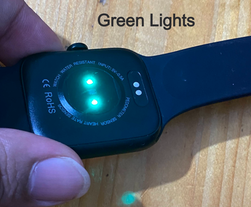How does smartwatch sense Oxygen Saturation (SpO2) Level!!
- Subir Biswas

- Dec 26, 2020
- 2 min read
Updated: Jul 11, 2025
Earlier the smartwatches available with only pulse sensor. But in 2020 the smartwatches available with the oxygen saturation (SpO2) level or termed as Pulse Oximetry. Here is the details.
What is Pulse Oximetry?
Pulse oximetry is the a process to measure the oxygen saturation (SpO2) level. Oxygen saturation is defined as the measurement of the amount of oxygen dissolved in the blood. This measurement is based on the detection of Hemoglobin (HbO2) and Deoxyhemoglobin (Hb, the form of hemoglobin without oxygen).
Image credit: Apple
How the Pulse Oximetry works in real life?
Two different light wavelengths (one red and one infrared) are used to measure the actual difference in the absorption spectra of HbO2 and Hb. The bloodstream is affected by the concentration of HbO2 and Hb, and their absorption coefficients are measured using two wavelengths 660 nm (red light) and 940 nm (infrared light). Deoxygenated and oxygenated hemoglobin absorb different wavelengths. Deoxygenated hemoglobin (Hb) has a higher absorption at 660 nm and oxygenated hemoglobin (HbO2) has a higher absorption at 940 nm.
Both medical and wearable oximeters use light to perform the task, but in different way. The above description is applicable of the medical equipment only. In the medical field, this is a small devices that resemble a clip and measured in finger, toe, and sometimes in earlobe. Wearable devices (smartwatch, fitness tracker works in a different fundamental.
Pulse Oximetry for wearable devices.
An optical O2 sensor for wearable devices consists of the followings.
A light-emitting diode (LED),
an inert carrier holding the light-sensitive layer where dye molecules are embedded in a polymer matrix and protected by an optical insulation layer,
and a photodiode plus filter to quantify the emitted light.
How to quantify the O2 concentration ?
The emission light is time-delayed with respect to the excitation light. The time shift between excitation and emission light is independent from the intensity. It is proportional to the partial pressure of O2 and acts as a measure for the O2 concentration.
What actually happens in the absence or presence of oxygen in the blood?
Absence:
If there is no oxygen is present in a particular time, the dye absorbs excitation light which is emitted by the LED and it gets transferred to a higher energy level and the lights starts emit once again. The emission light will be delayed and has a different wave length as well. The filter (mention in the component list list shown in figure above) in front of the photodiode ensures that only emitted light is detected.
Presence:
If oxygen is present in that particular time, the dye absorbs the excitation light which is emitted by the LED, but in its excited state the energy is taken over by oxygen molecules. The dye has now less energy left to emit. The more oxygen, the less emitted light gets to the photodiode though the filter.
The sensor’s characteristics played a vital role in this case and it is very good for the wearable devices.
It is Non-destructive, that means no oxygen consumed during measurement.
It is very much user-friendly because no electrolyte needed.
And it is ecofriendly as well as no chemicals used.































Comments